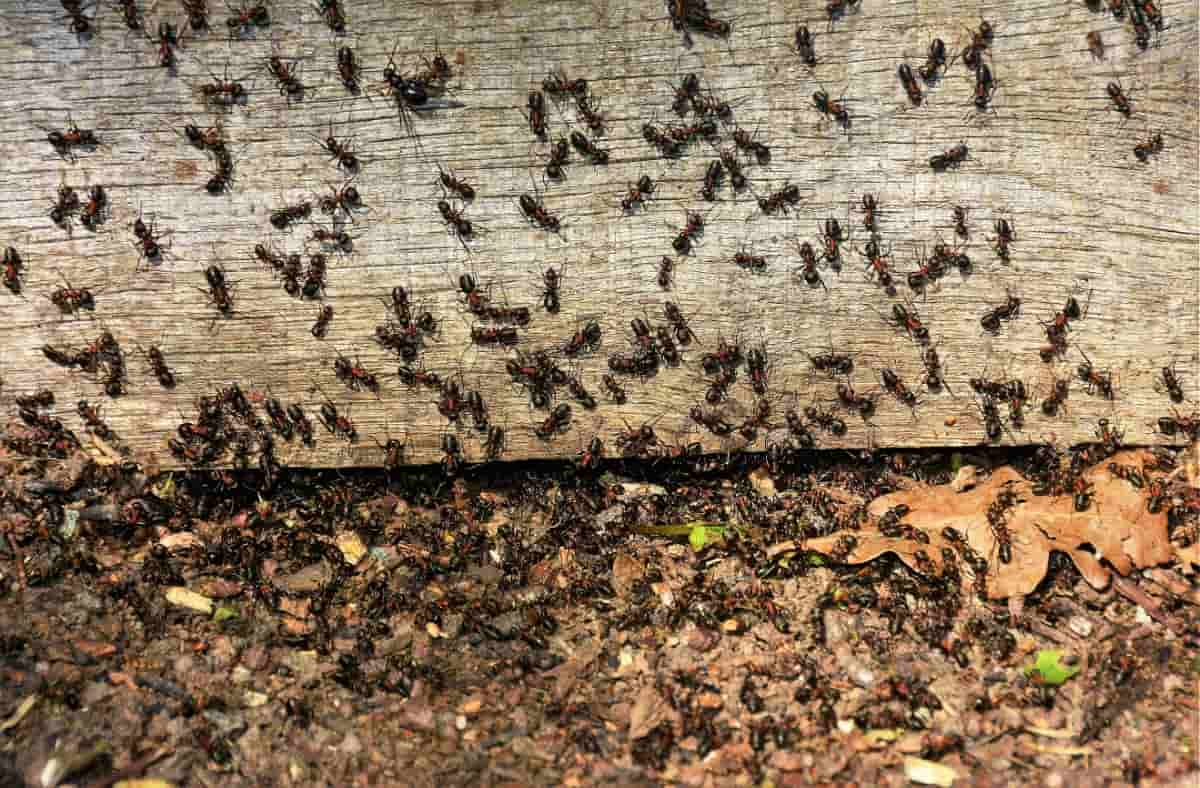Dealing with unwanted pests like ants in your compost bin can be challenging sometimes. Ants are attracted to compost bins because of the abundance of organic matter, which provides them with a steady food source. Even though they aren’t necessarily harmful to the composting process, their presence can be a nuisance and potentially disrupt the balance of your compost. This guide will briefly discuss some effective tips and natural prevention techniques to help you eliminate ants in your compost bin and maintain a thriving composting environment.

How to Get Rid of Ants in Compost Bin
Ants in Compost Bin Good Or Bad: Do They Benefit or Harm the Composting Process?
Composting can be affected either positively or negatively by ants. On the one hand, they aid decomposition by breaking down organic matter and aerating the compost pile as they tunnel through it. Their movement promotes microbial activity, enhancing the breakdown of materials.
However, excessive ant activity can disrupt the composting process. They may disturb the carefully balanced conditions, causing temperature fluctuations or uneven moisture distribution. Furthermore, ants might be attracted to kitchen scraps or other non-compostable materials, diverting their energy away from the actual decomposition process.
Identifying Common Ant Species in Compost Bins: Prevention and Control Strategies
Compost bins often host various ant species attracted by the rich organic matter. Common species include the Odorous House Ant, known for its coconut-like odor when crushed. Another is the Argentine Ant, forming expansive colonies. The Red Imported Fire Ant may also appear, delivering painful stings. Pavement Ants construct small mounds near bins. The Acrobat Ant also can nest in moist compost. While these ants aid in decomposition, some might disrupt the composting process.
Natural Repellents for Ants in Compost Bin/Ants in Compost Tumbler
- Citrus Peels: Place citrus peels like orange or lemon around the bin as ants dislike their scent.
- Diatomaceous Earth: Use food-grade diatomaceous earth around the bin. Its fine particles deter ants.
- Cinnamon: Spread cinnamon powder along the bin’s perimeter as its strong scent repels ants.
- Vinegar: Create equal vinegar and water solution, then spray it around the bin to discourage ants.
- Mint Leaves: Plant mint near the bin or use an essential oil on cotton balls, as ants dislike mint’s aroma.
- Baking Soda: Scatter baking soda near the bin as ants are averse to its texture.
In case you missed it: How to Get Rid of Maggots in Compost Bin: Tips and Natural Prevention Techniques

Maintaining Proper Moisture Levels in Compost to Deter Ants: Best Practices
Maintain moisture between 40-60%. Keep compost aerated and turn it on regularly to prevent waterlogging. Use dry materials like leaves and straw to absorb excess moisture. Avoid sweet or oily food scraps that attract ants. Ensure proper drainage and use a closed compost bin with a tight-fitting lid.
Elevate the bin on some heights to discourage ant access. Address ant infestations promptly using non-toxic ways like using diatomaceous earth or vinegar solutions on ant trails. Controlling moisture and employing preventive measures can stop entering your compost bins and foster effective composting.
Regular Turning and Aeration of Compost to Reduce Ant Activity
Turning the compost disrupts ant nests, exposing them to air and sunlight, which they dislike. This disturbs their nesting environment and discourages their presence in your compost. Aeration enhances decomposition through the mixing process, generating heat that ants find unfavorable. And also, the increased airflow minimizes moisture, making the compost less appealing to ants seeking damp habitats. These practices disrupt ant colonies, making the compost less habitable for them while promoting the breakdown of organic matter.
Using Physical Barriers to Prevent Ants from Accessing Compost Bins
- Surround the bin’s base with a moat-like structure filled with water, as ants can not able reluctant to cross water.
- Apply double-sided tape around the bin’s legs, repelling ants due to their aversion to sticky surfaces.
- Sprinkle food-grade diatomaceous earth(DE) around the bin. Its abrasive particles deter ants and absorb their protective waxy coating, causing dehydration.
- Utilize ant-proof mesh or fabric covers to seal the bin’s openings while ensuring proper ventilation.
- Elevate the bin on sturdy legs and place the legs in dishes of soapy water, forming a barrier ants cannot traverse.
- Employ natural deterrents like cinnamon, citrus peels, or mint leaves around the bin’s perimeter, as ants dislike these scents.
- Regularly clean the bin’s surrounding area to eliminate potential food sources, discouraging ants.
In case you missed it: Benefits of Kelp Meal for Plants: How to Use as Compost for Organic Gardening

Removing Existing Ant Nests in Compost Bins
- First, ensure you’re wearing gloves and protective clothing. Empty the bin’s contents onto a tarp in a sunny area.
- Gently break apart the compost, exposing the ant nests. Use a garden fork to turn the compost, helping to disturb the nests carefully. This will encourage ants to relocate.
- Inspect the bin for remaining nests and manually remove them using a trowel.
- Clean the bin’s interior with water and vinegar solution to eliminate ant scent trails.
- Allow the bin to dry thoroughly before refilling it with compost materials.
Red Ants in Compost/Fire Ants in Compost Bin/Carpenter Ants in Compost Pile
Like many other ant species, red ants can aid in the decomposition process by breaking down organic matter. However, their presence might signal imbalances in your compost, such as too much nitrogen-rich material. On the other hand, fire ants can be problematic. Their aggressive nature and painful stings pose risks to both humans and animals.
If fire ants infest your compost bin, addressing the issue is important to avoid potential harm. Carpenter ants are usually drawn to decaying wood, and their presence in a compost pile could suggest overly woody or damp conditions. While they aid in wood decomposition, their tunneling behavior might destabilize the pile’s structure.
To manage ants in your compost, ensure a balanced mix of green and brown materials, proper aeration, and moisture control. Regular turning of the compost can discourage ants by disrupting their nests. Consider relocating the bin to a safer area or employing ant-repelling techniques for fire ants. If the ant population becomes uncontrollable, seek professional pest control advice.
Monitoring and Early Detection of Ant Infestations in Compost Bins
It is essential for maintaining the efficiency of composting systems and preventing potential pest-related issues. Regular visual inspections of compost bins, paying attention to ant activity, nest formation, and changes in compost texture, provide initial insights. Employing non-toxic ant baits near bins can attract ants and indicate their presence.
In case you missed it: From pH Levels to Composting: How to Prepare the Best Soil for Your Flower Garden

Additionally, utilizing temperature and moisture sensors within bins can reveal conditions conducive to ant infestations. Early identification allows for targeted interventions such as altering bin maintenance practices, adjusting compost moisture levels, or relocating bins if needed. Swift response through this comprehensive strategy ensures healthy composting and minimizes ant-related challenges.
Conclusion
Successfully managing ants in your compost bin involves a combination of strategic practices and a solid understanding of their behavior. Remember that a few preventive measures ensure the success of your composting journey while contributing to a sustainable and eco-friendly lifestyle.
- Feed Your Flock for Less: Top 10 Tips to Save on Chicken Feed
- Ultimate Guide to Ossabaw Island Hog: Breeding, Raising, Diet, and Care
- Hatching Answers: The Top 10 Reasons Your Chickens Aren’t Laying Eggs
- Eggs and Economics: Breaking Down the Cost of Raising Backyard Chickens
- Defend Your Greens: Proven Methods to Keep Iguanas Out of Your Garden
- Ultimate Guide to Cinnamon Queen Chicken: A Comprehensive Guide for Beginners
- Ultimate Guide to California Tan Chicken: Breeding, Raising, Diet, Egg-Production and Care
- Ultimate Guide to Marsh Daisy Chicken: Breeding, Raising, Diet, and Care
- 10 Types of Chicken Farming Businesses You Can Start for Profits